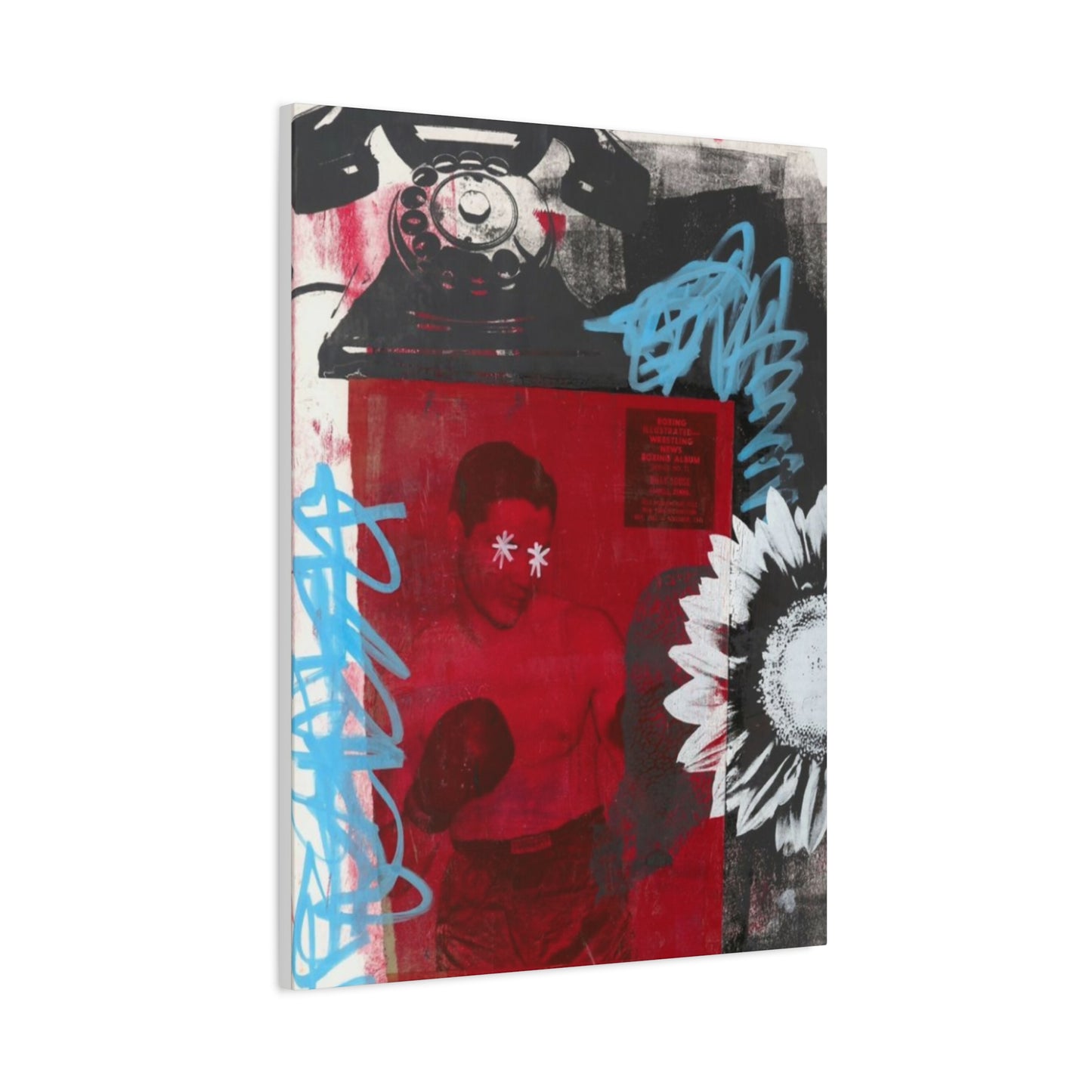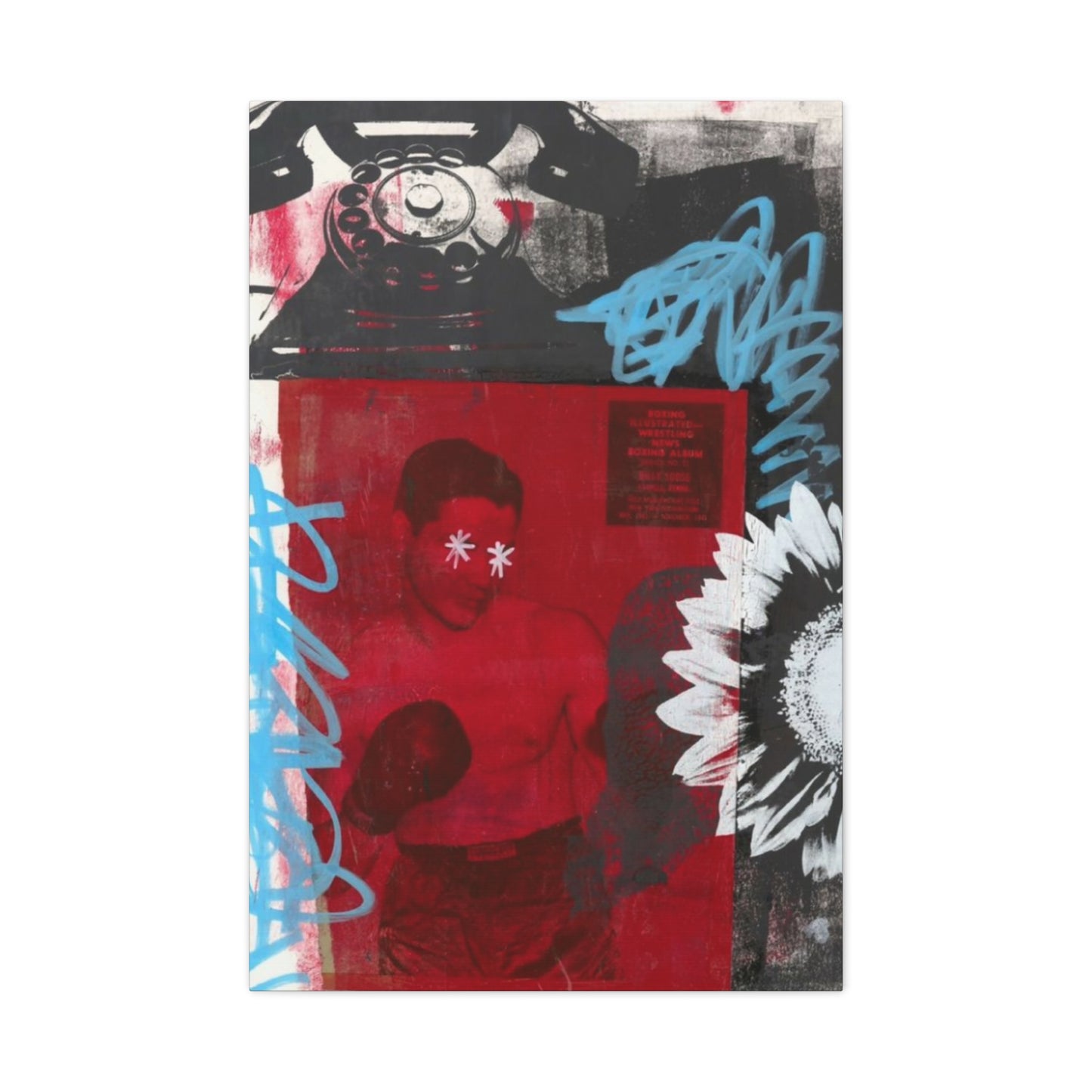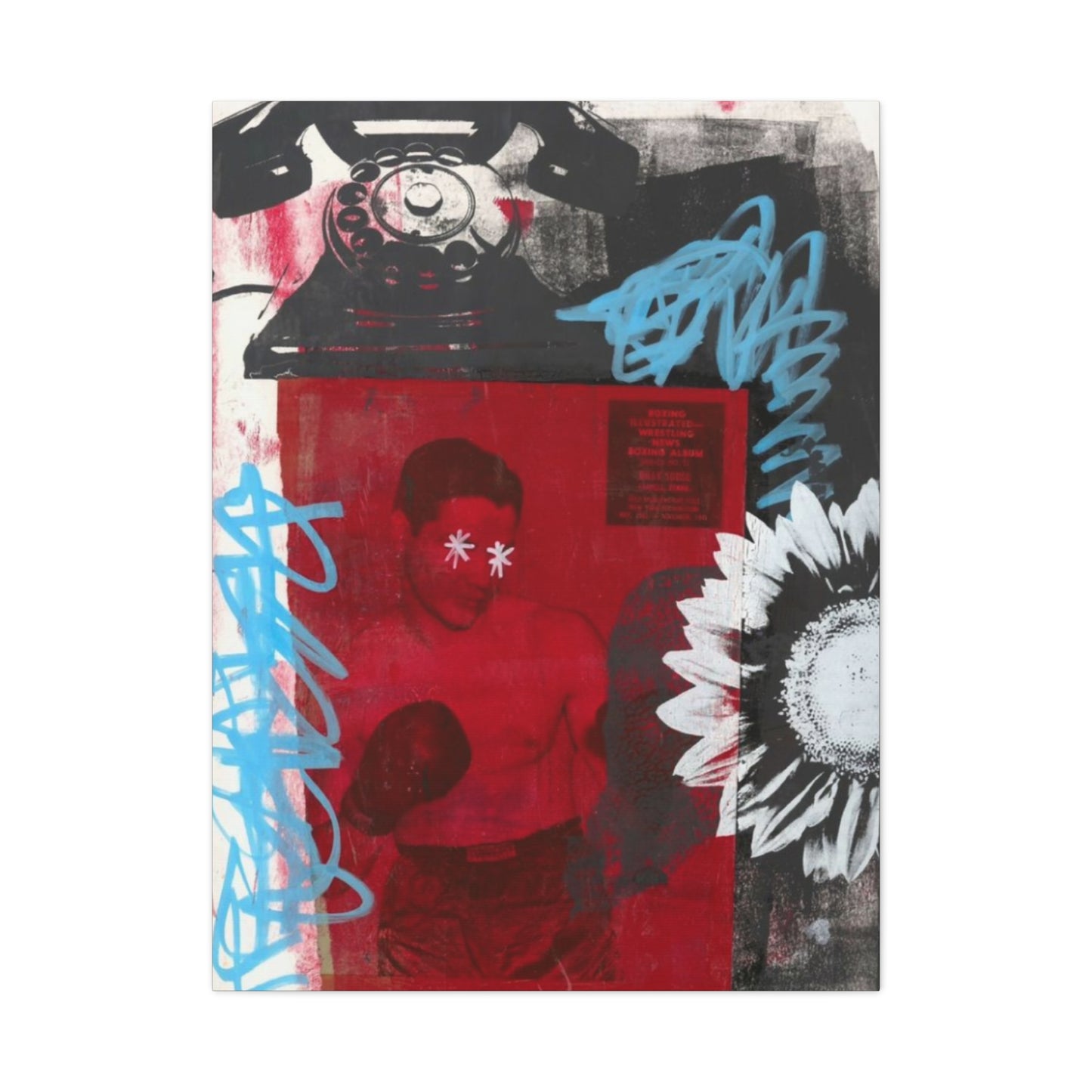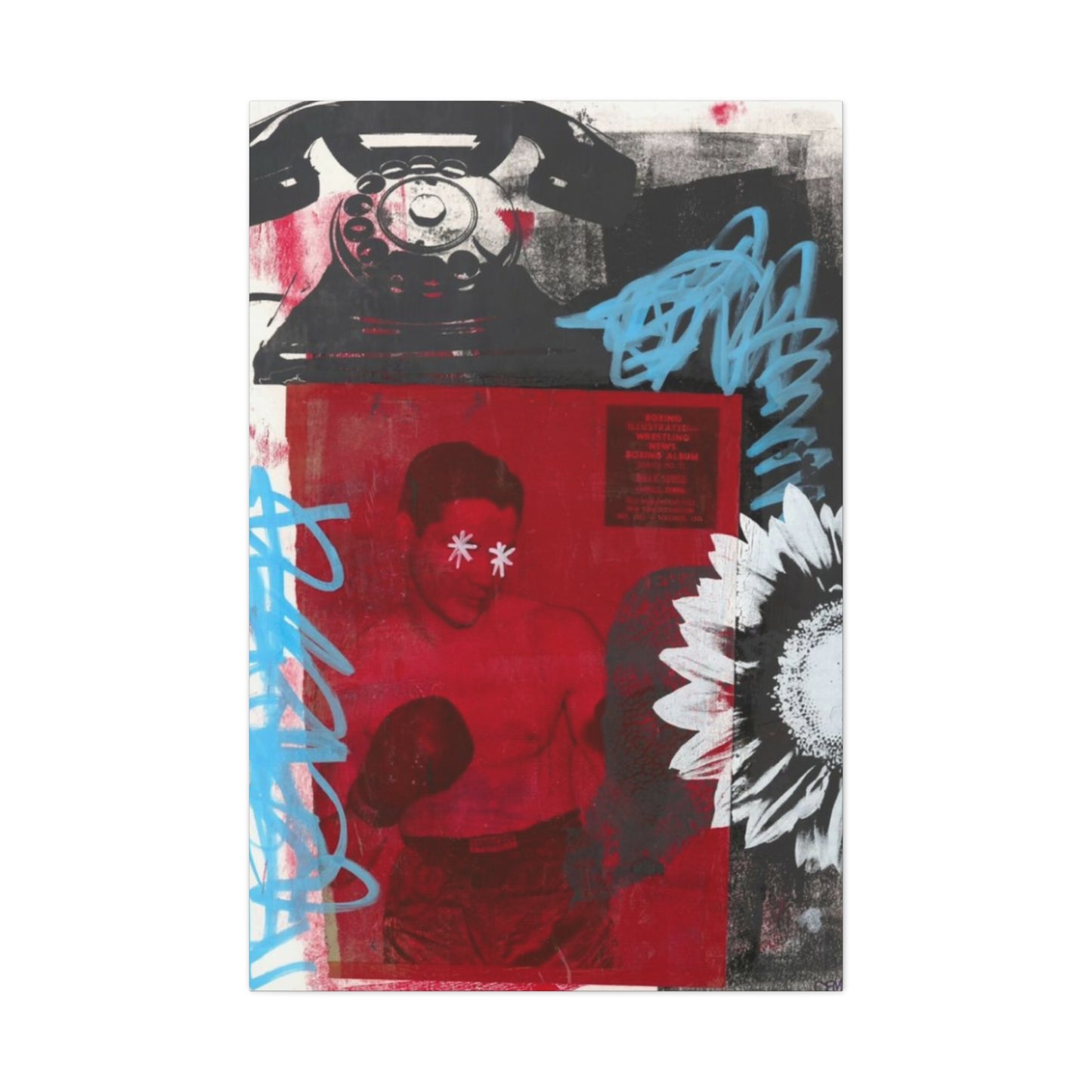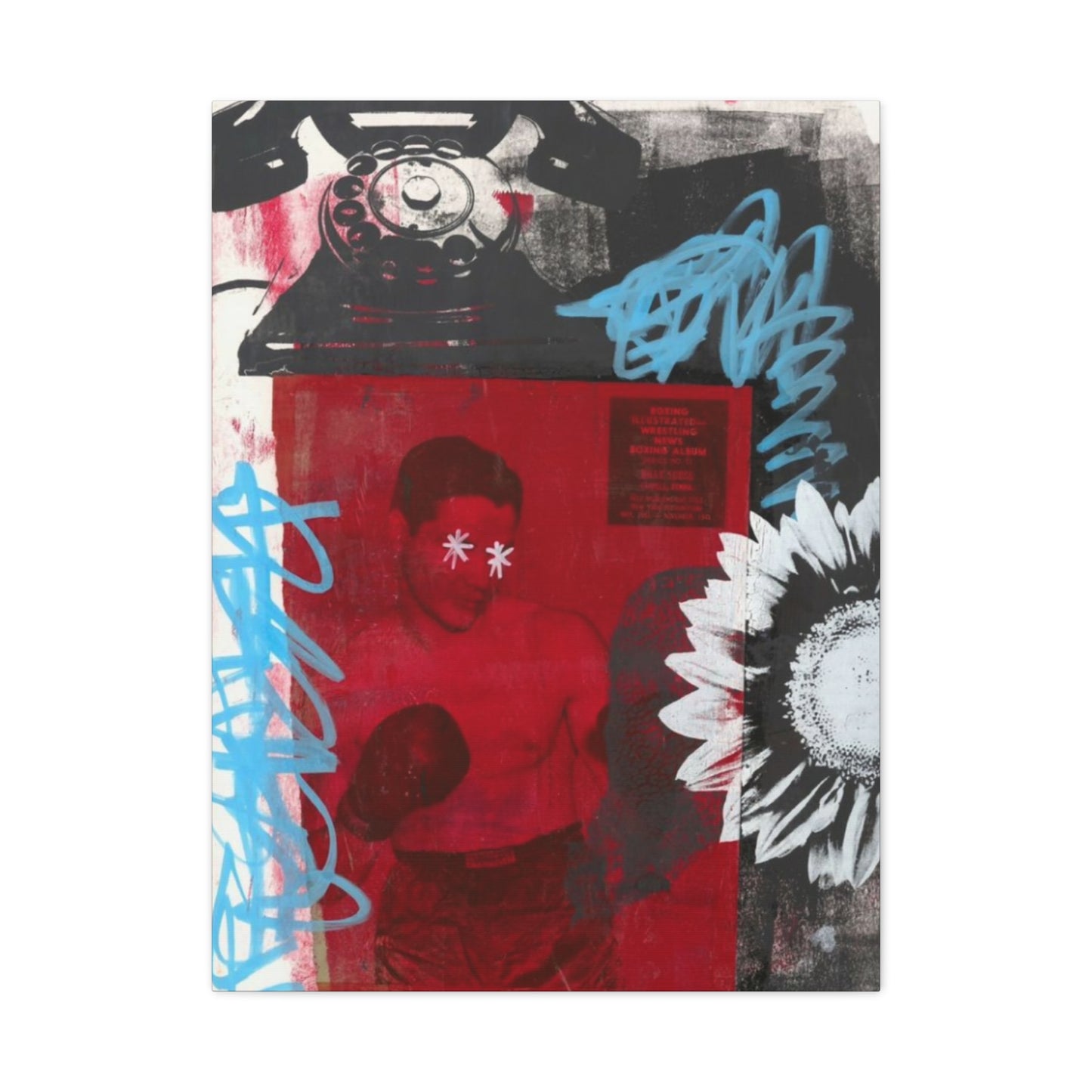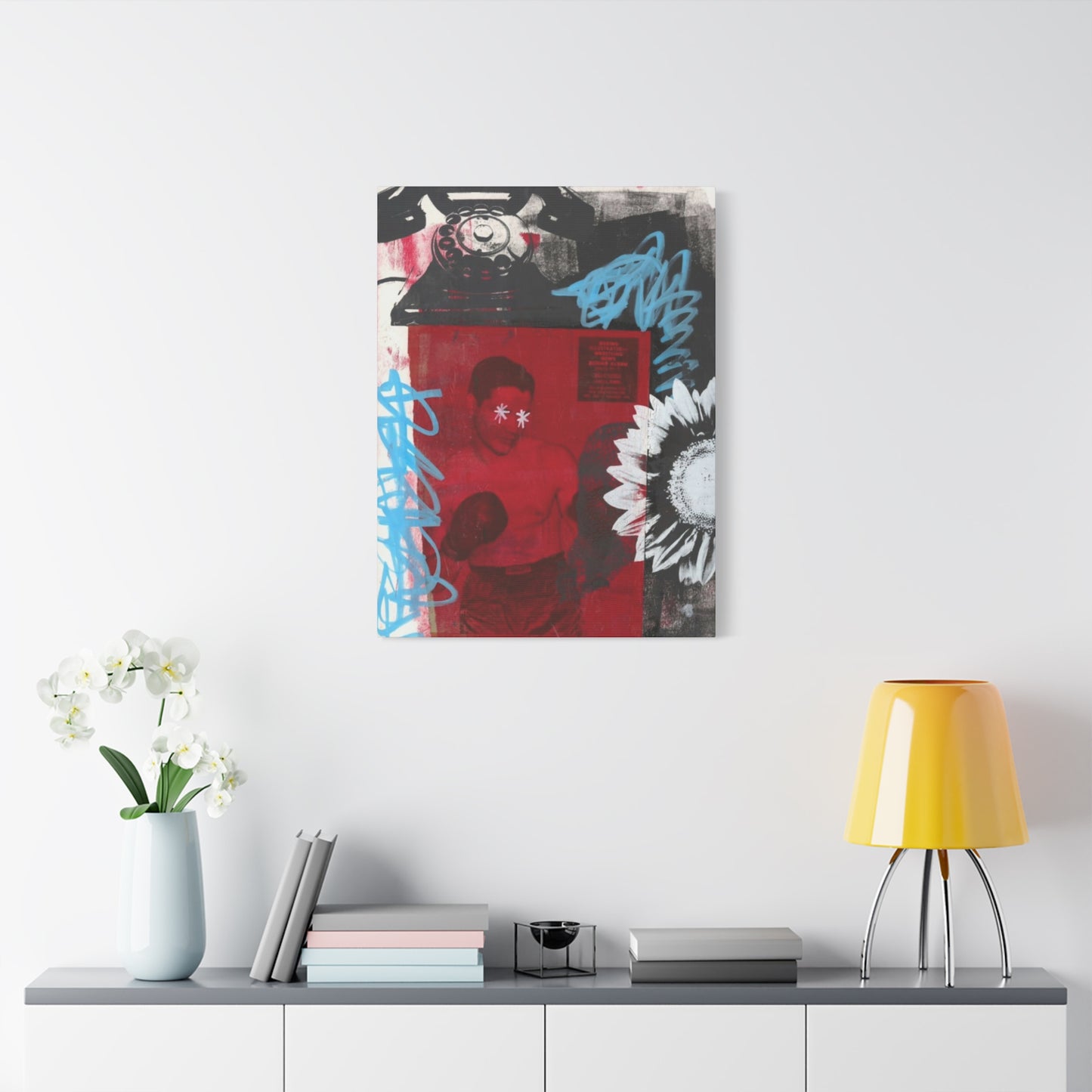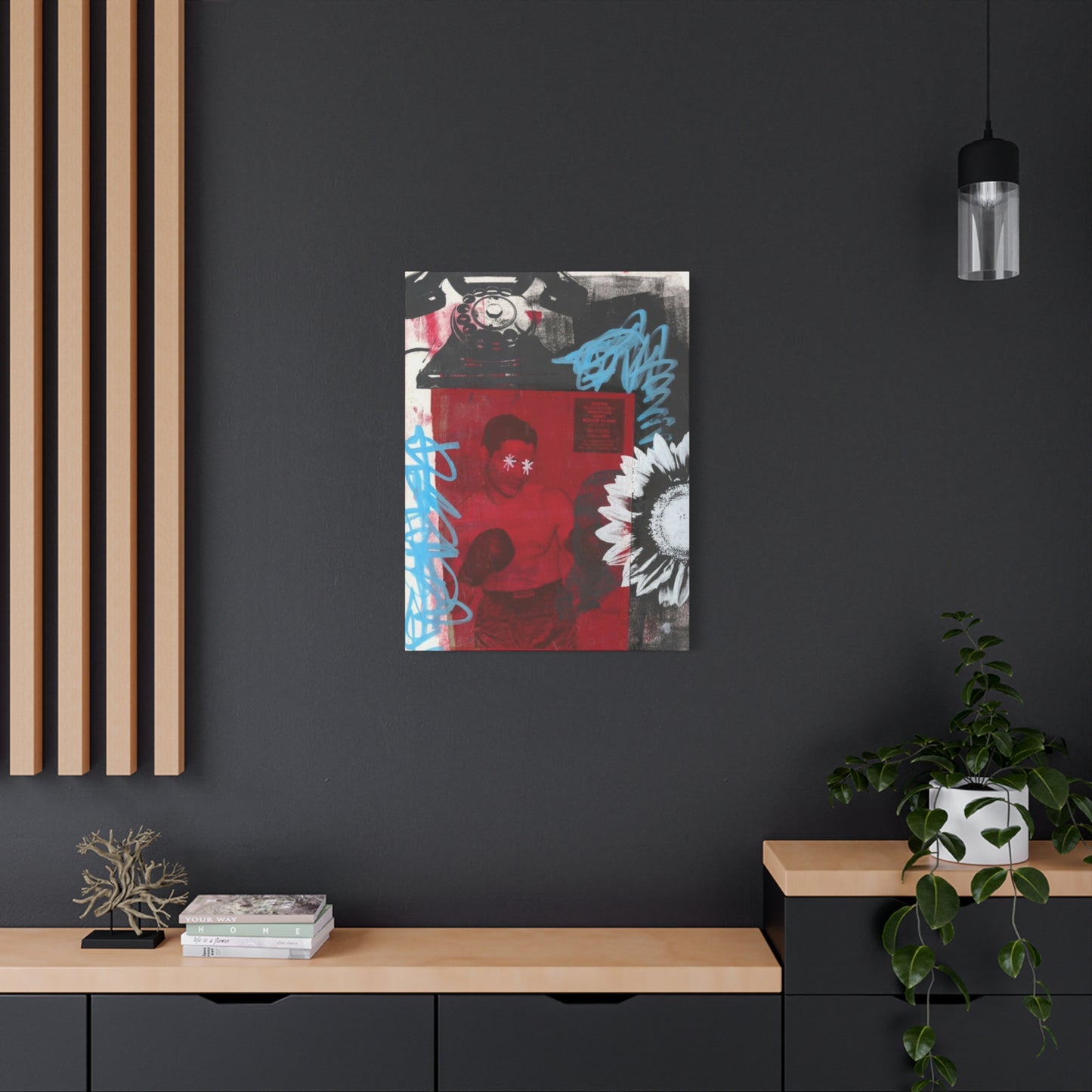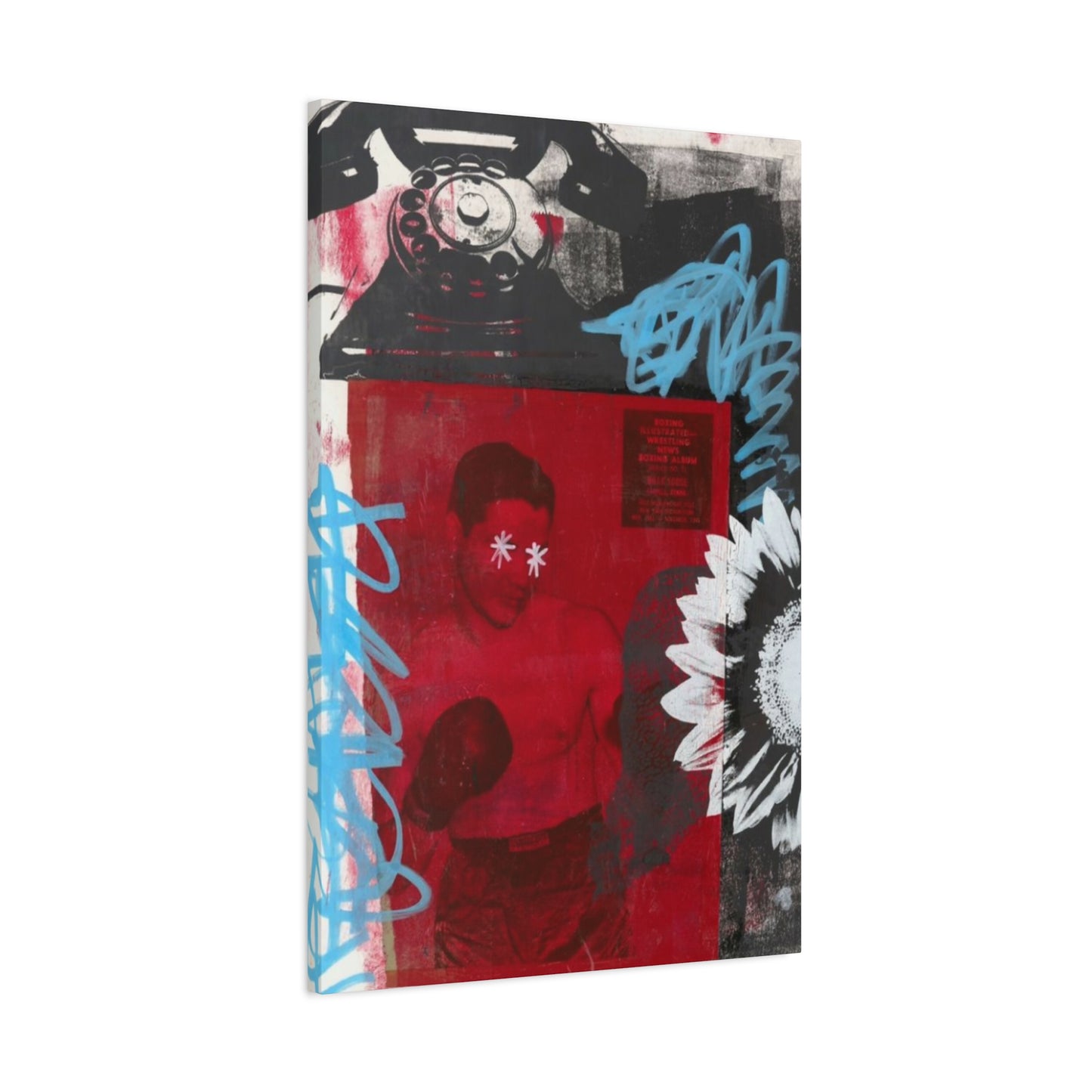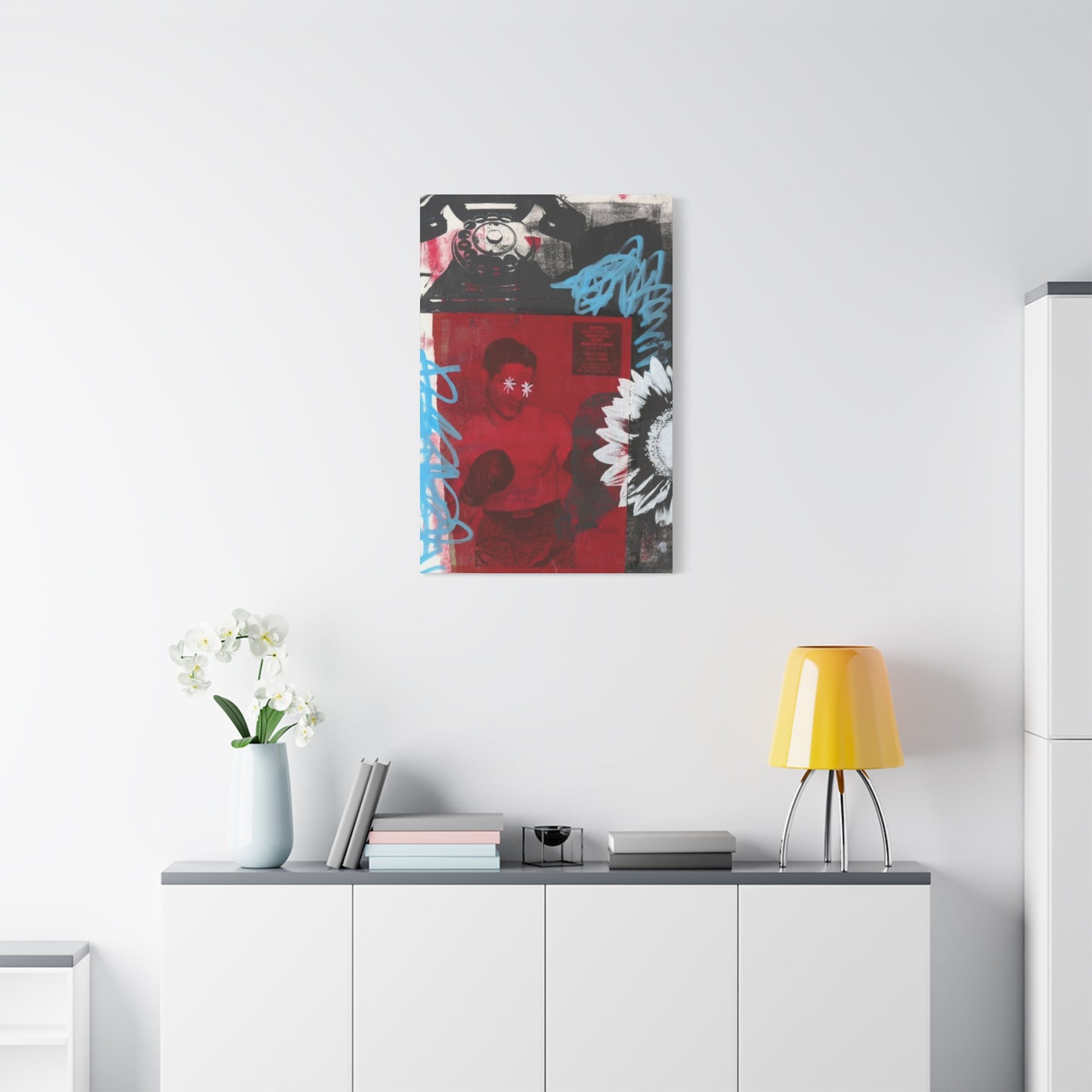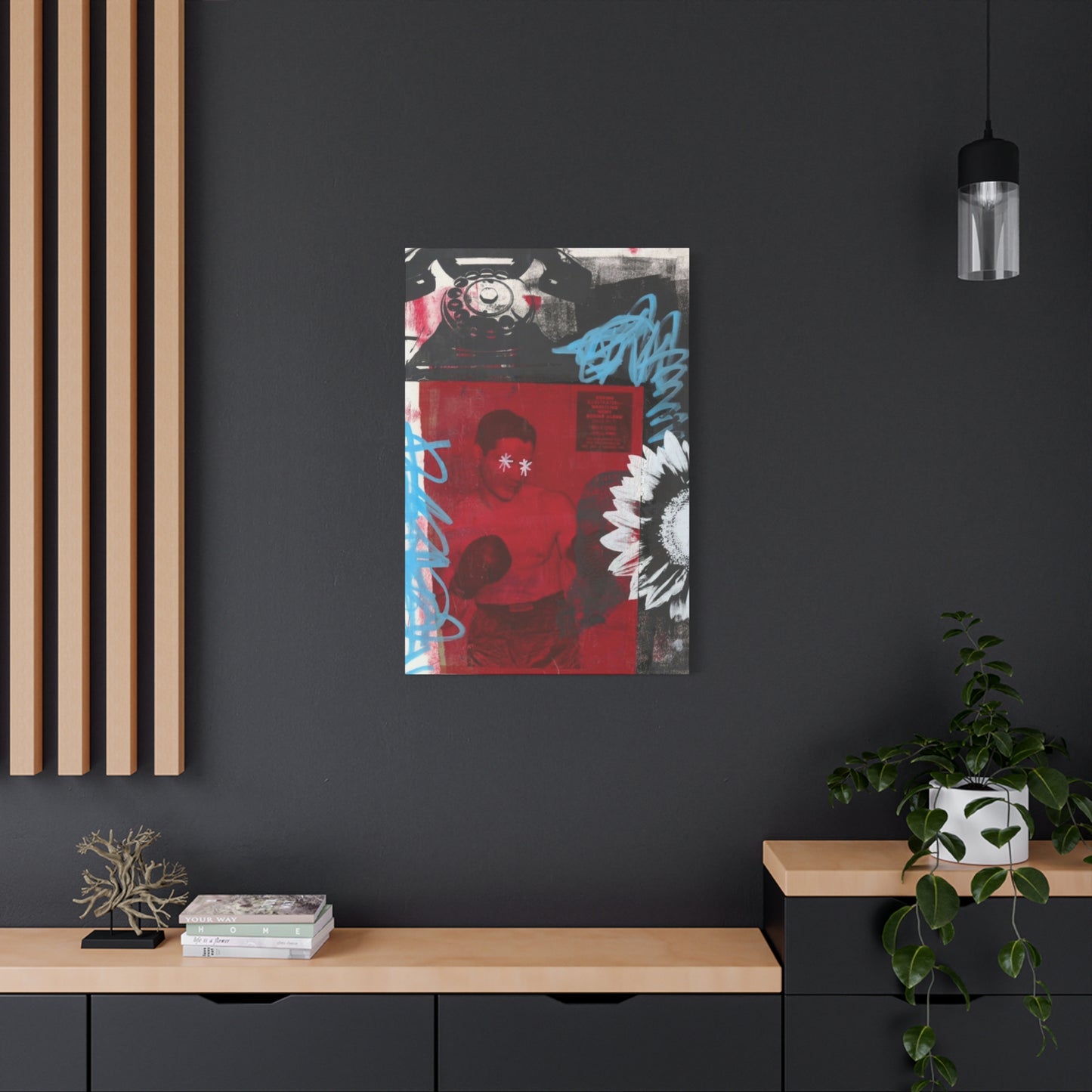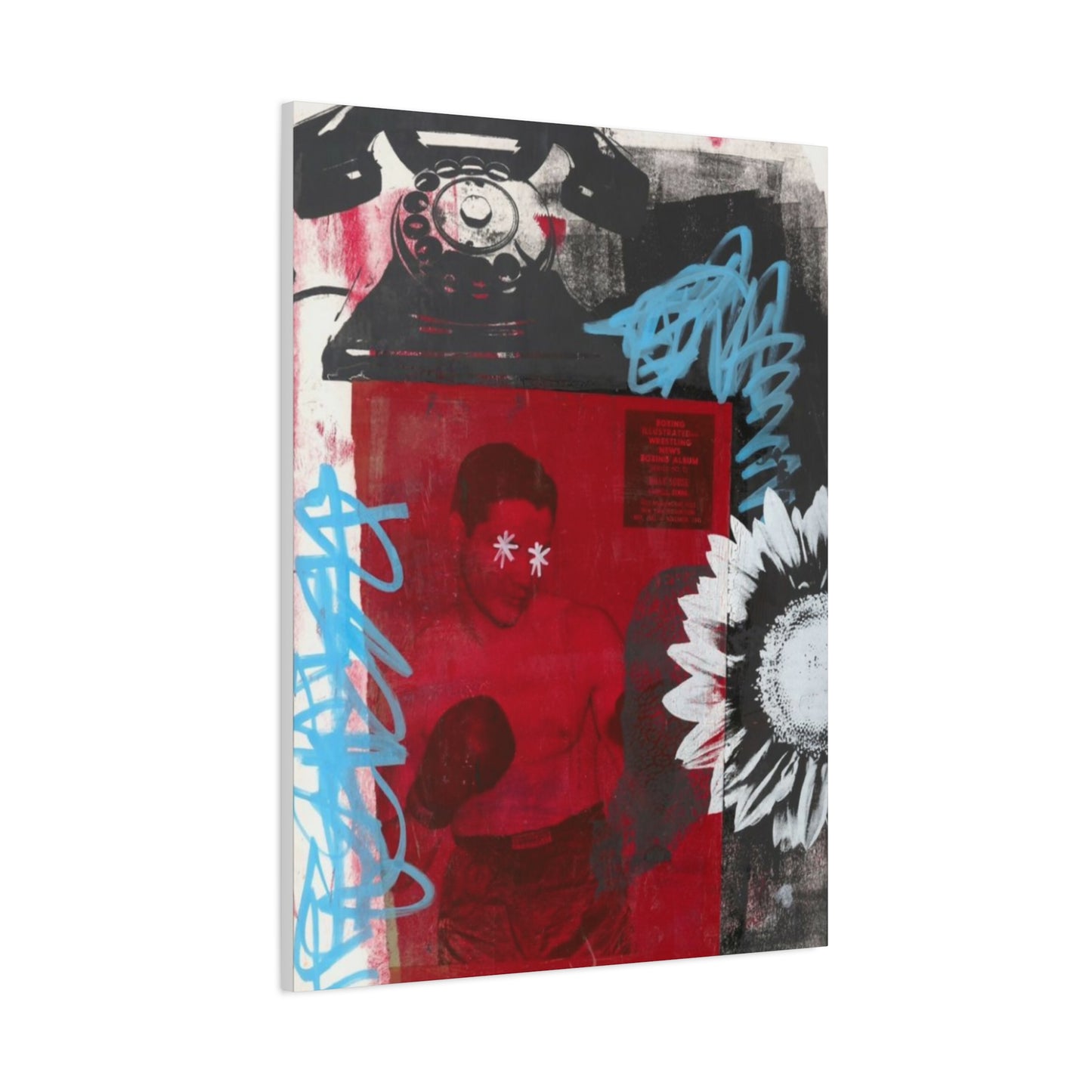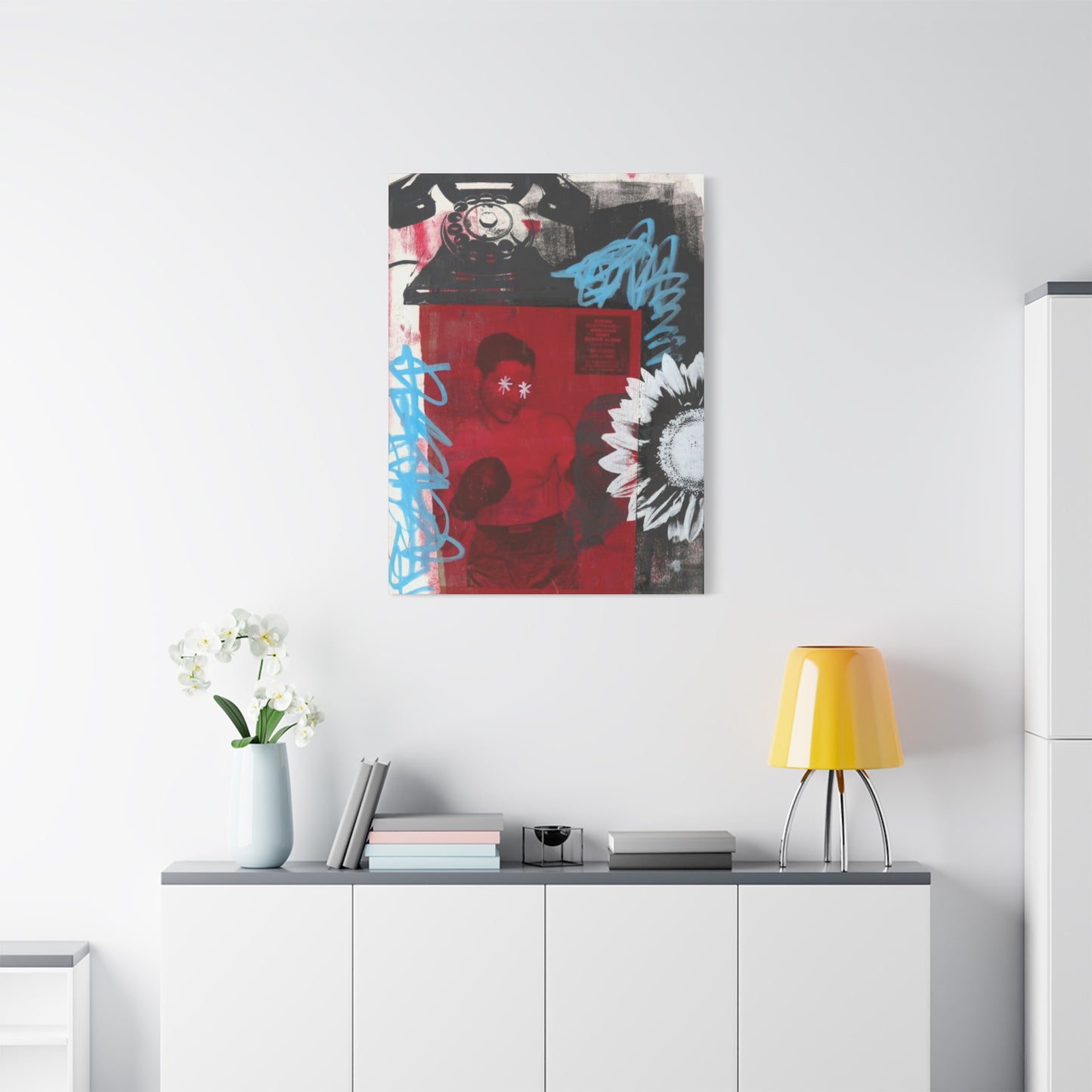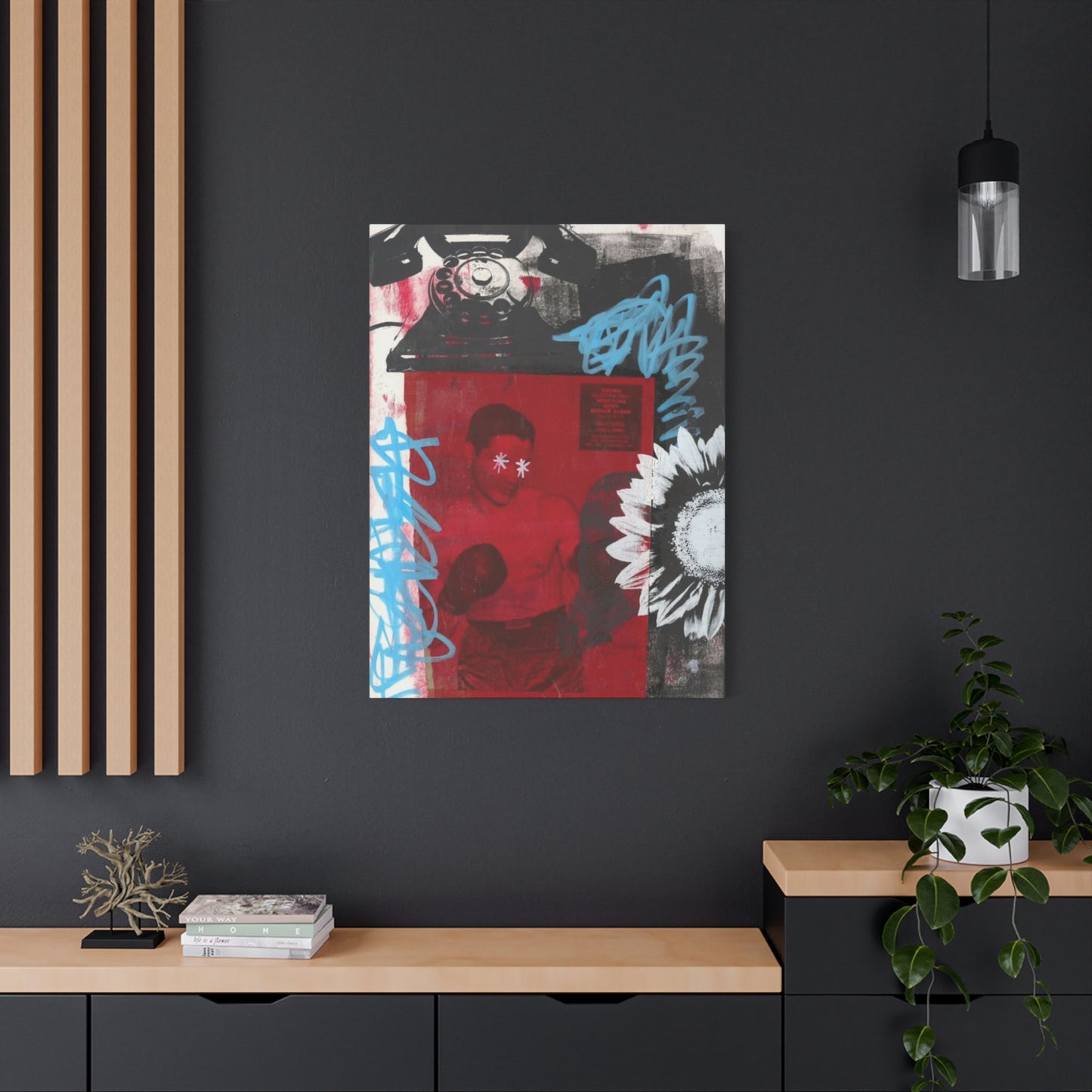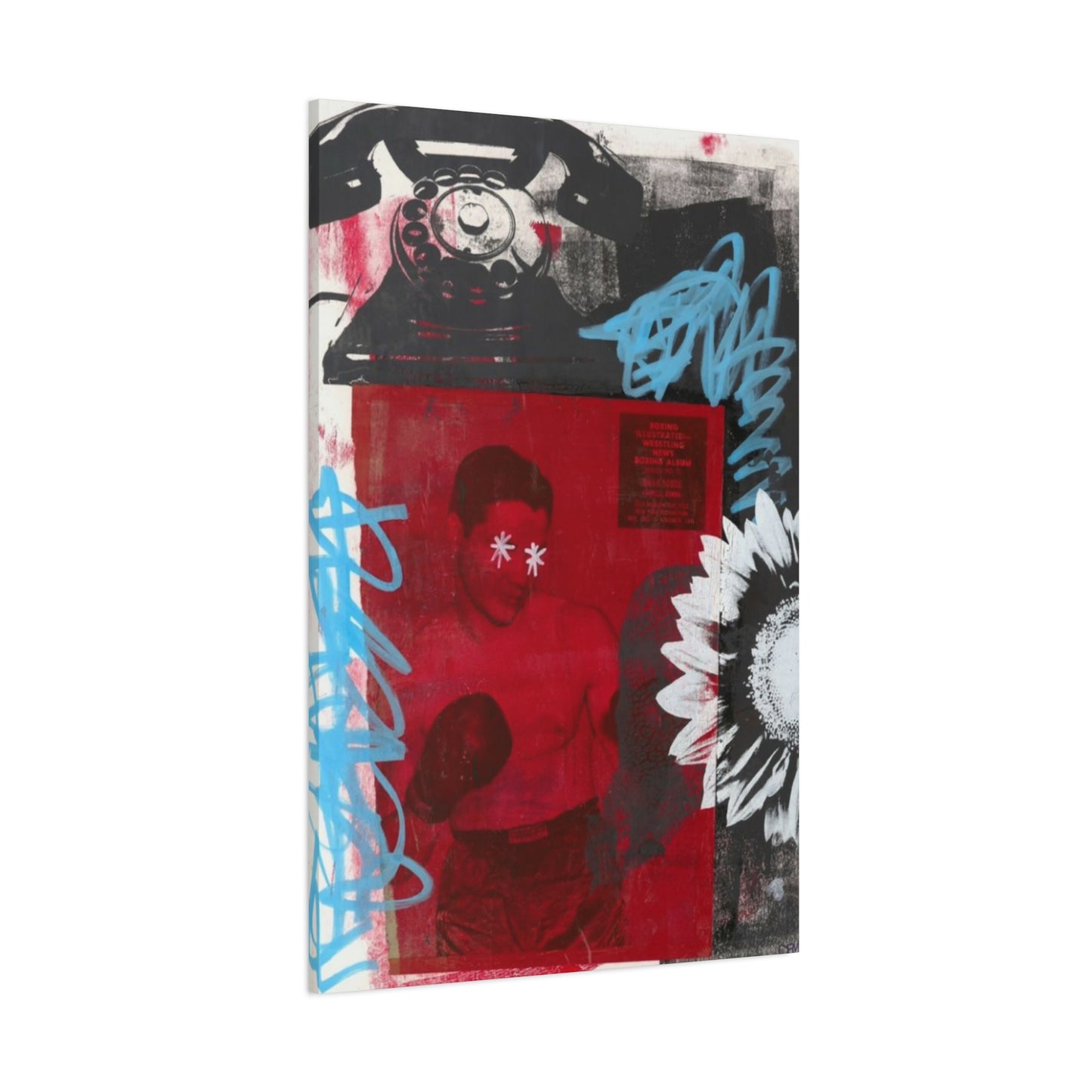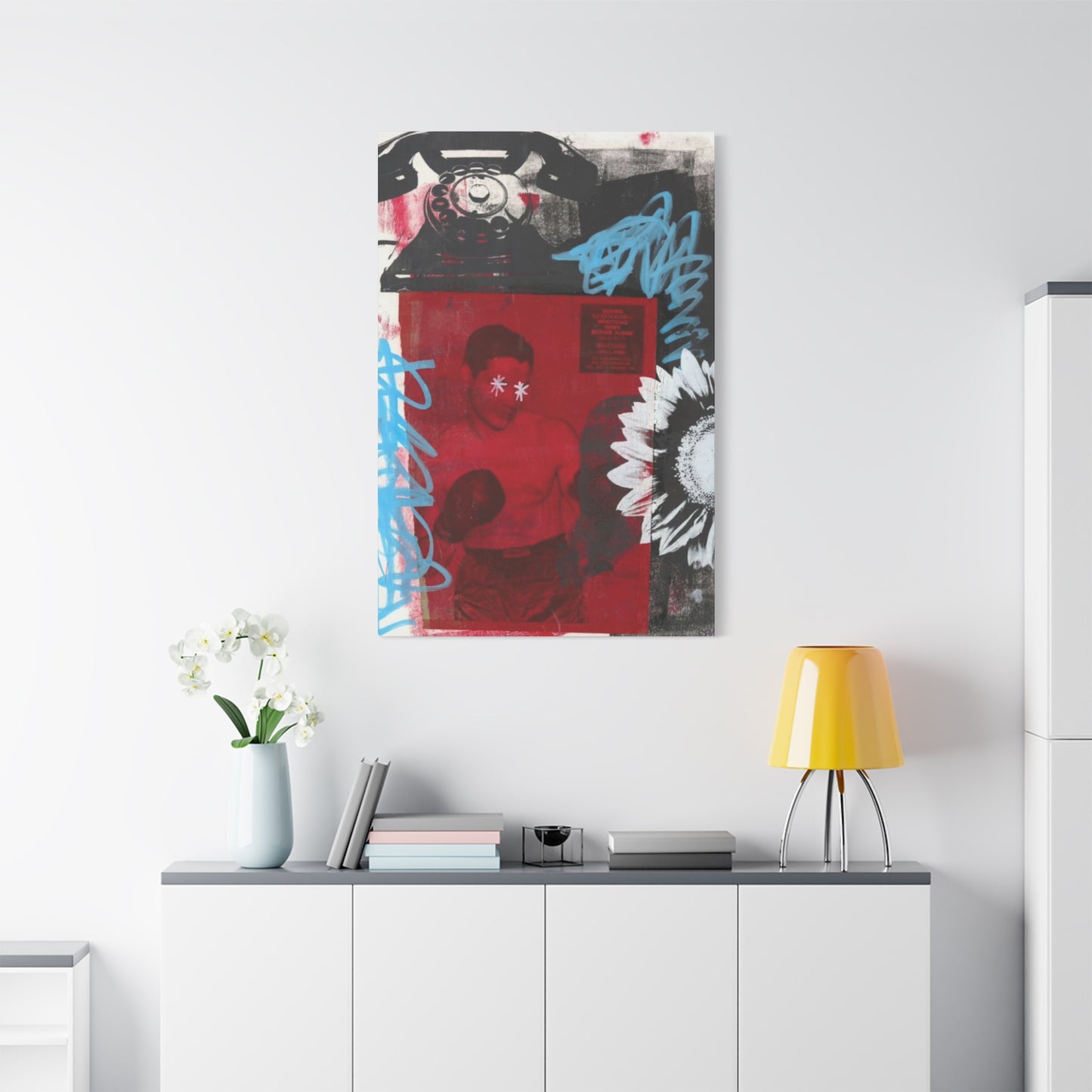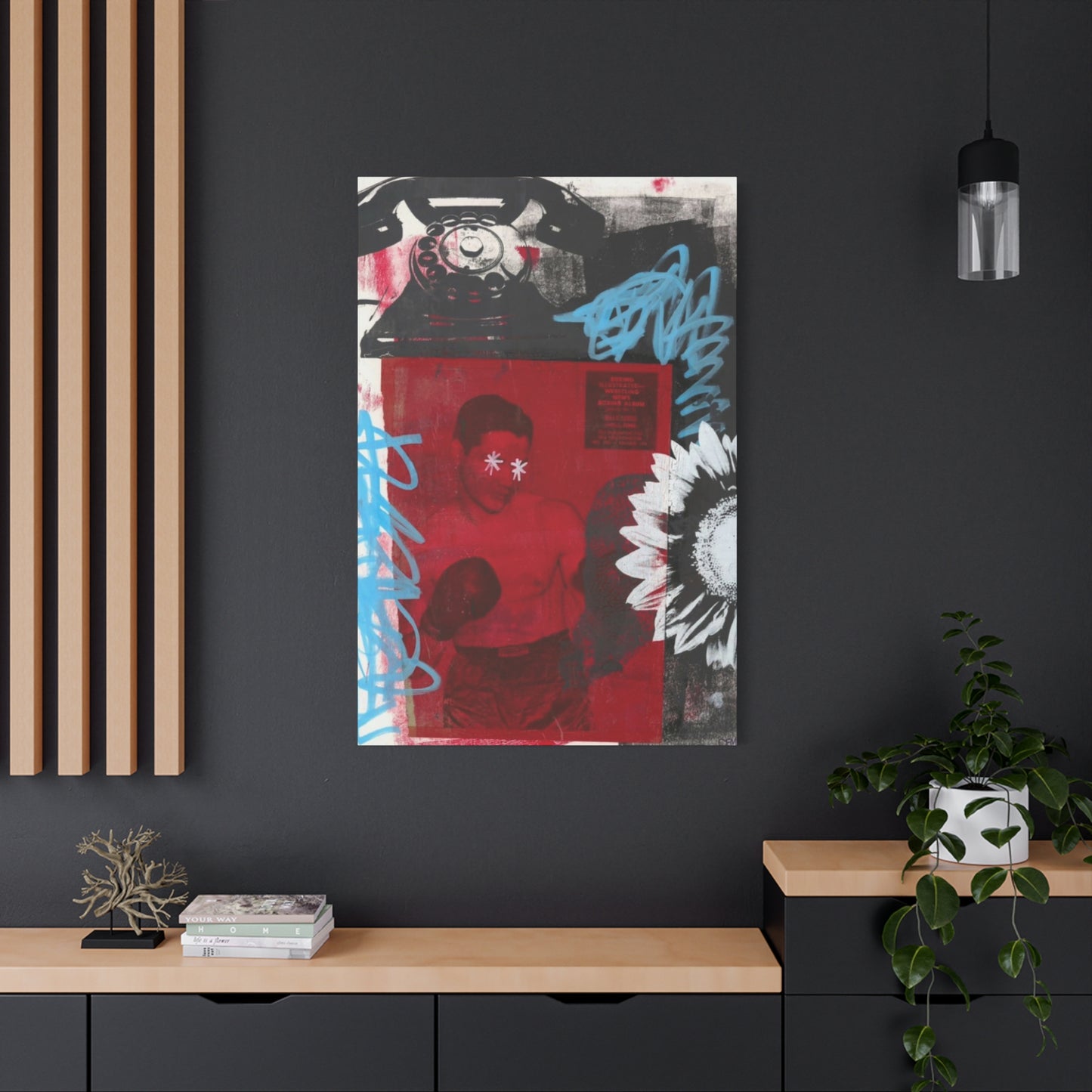Mixed Media Boxing and Telephone Wall Art: Creative Expression Through Athletic and Retro Themes
Mixed media artwork combining boxing themes with vintage telephone imagery creates powerful visual statements that command attention in any space. These artistic compositions merge the raw intensity of athletic pursuits with the nostalgic charm of communication devices from bygone eras, resulting in pieces that serve as compelling conversation starters and dramatic focal elements.
The strategic placement of such artwork transforms ordinary walls into dynamic galleries that reflect both personal interests and sophisticated aesthetic sensibilities. Boxing imagery brings forth themes of determination, resilience, and physical prowess, while vintage telephone elements introduce layers of nostalgia, communication, and human connection. This juxtaposition creates visual tension that draws viewers in, encouraging them to explore the deeper meanings embedded within the composition.
When selecting mixed media pieces featuring these themes, consider how the artwork will interact with existing elements in your space. The bold, angular forms typical of boxing imagery contrast beautifully with the curved lines and mechanical details of vintage telephones, creating a balanced composition that feels both energetic and contemplative. These pieces work exceptionally well in spaces where you want to encourage dialogue and reflection, such as living rooms, offices, or recreational areas.
The color palettes often found in boxing and telephone mixed media art tend toward rich, saturated tones that can anchor a room's design scheme. Deep reds reminiscent of boxing gloves, metallic silvers and blacks echoing vintage telephone hardware, and warm sepia tones that suggest aged photographs all contribute to a sophisticated color story that complements both modern and traditional interior designs.
Lighting plays a crucial role in maximizing the impact of mixed media artwork. These pieces often incorporate textural elements, layered papers, metallic accents, and dimensional components that respond beautifully to both natural and artificial lighting. Consider installing adjustable track lighting or picture lights that can highlight the various textures and create subtle shadows that enhance the dimensional quality of the artwork.
The scale of mixed media boxing and telephone prints should be proportionate to the space they occupy while maintaining enough presence to serve as true focal points. Large-scale pieces work well in spacious rooms with high ceilings, while medium-sized compositions can effectively anchor smaller areas without overwhelming the space. Gallery walls featuring multiple smaller pieces allow for more flexibility in arrangement and can be adjusted over time to reflect changing preferences.
Discovering Retro Charm in Contemporary Mixed Media Artwork
The integration of vintage elements into modern mixed media art creates a fascinating dialogue between past and present, offering viewers a rich tapestry of visual and emotional experiences. Retro telephone imagery, with its mechanical precision and nostalgic associations, provides an excellent counterpoint to contemporary artistic techniques and materials, resulting in pieces that feel both timeless and current.
Vintage telephone imagery evokes memories of a different era of communication, when conversations required physical presence at a specific location and carried greater intentionality. These associations add emotional depth to mixed media compositions, creating layers of meaning that extend beyond mere aesthetic appeal. The mechanical beauty of rotary dials, the elegant curves of handset receivers, and the substantial presence of desk phones from decades past all contribute to a visual vocabulary that speaks to craftsmanship, permanence, and human connection.
Contemporary mixed media artists often combine these vintage elements with modern materials and techniques, creating exciting juxtapositions that highlight both the enduring appeal of retro aesthetics and the innovative possibilities of current artistic practices. Digital printing techniques allow for precise reproduction of vintage telephone imagery, while traditional painting and collage methods add texture and handmade quality that enhances the nostalgic appeal.
The patina of age, whether authentic or artistically created, adds character and depth to mixed media pieces featuring vintage themes. Sepia tones, aged paper textures, distressed surfaces, and weathered metal effects all contribute to the sense that these pieces carry history within them. This quality makes them particularly appealing to collectors and art enthusiasts who appreciate the layered complexity that time and experience bring to artistic expression.
Color palettes in retro-themed mixed media art often draw from the design sensibilities of specific decades, incorporating the muted earth tones of the 1970s, the bold primary colors of mid-century modern design, or the elegant blacks and silvers associated with Art Deco styling. These historical color references help establish the temporal context of the piece while providing rich, sophisticated options for interior design coordination.
The texture is particularly important in mixed media art featuring vintage themes, as it helps convey the tactile qualities associated with older objects and materials. Layered papers, fabric elements, metal components, and painted surfaces combine to create pieces that invite closer inspection and reward viewers who take time to examine the various components and techniques employed by the artist.
Creating Wall Dimension Through Mixed Media Artistic Techniques
Mixed media art excels at creating visual and physical depth that transforms flat wall surfaces into engaging three-dimensional experiences. The combination of various materials, techniques, and artistic approaches allows artists to build layers of meaning and texture that conventional single-medium artwork cannot achieve, resulting in pieces that change and reveal new details as viewers examine them from different angles and distances.
The layering process fundamental to mixed media creation naturally produces dimensional effects that add architectural interest to wall surfaces. Base layers might include painted or printed backgrounds, over which artists apply additional elements such as collaged papers, fabric pieces, metal components, or textural materials. Each layer contributes to the overall depth of the piece while maintaining its own distinct character and purpose within the composition.
Textural variety is one of the most compelling aspects of mixed media wall art, as it engages multiple senses and creates visual interest that sustains attention over time. Smooth painted surfaces contrast with rough textural elements, matte finishes play against glossy components, and soft materials provide counterpoint to hard, industrial elements. This diversity of surface qualities ensures that the artwork continues to reward repeated viewing and exploration.
Shadow play becomes an important consideration when planning mixed media installations, as raised elements and varying surface textures create changing patterns of light and shadow throughout the day. These dynamic visual effects add life to the artwork, ensuring that it appears different under various lighting conditions and times of day. Strategic placement relative to windows, lamps, and other light sources can maximize these effects.
Color interaction takes on added complexity in mixed media pieces, as different materials reflect and absorb light in various ways, creating subtle shifts in color perception depending on viewing angle and lighting conditions. Metallic elements might catch and reflect light differently than matte painted surfaces, while translucent materials can create interesting overlay effects that shift as lighting changes.
The physical presence of mixed media artwork on walls creates a more immersive experience than traditional flat prints or paintings. Viewers become more aware of their physical relationship to the piece, as different viewing angles reveal different aspects of the composition. This quality makes mixed media art particularly effective in spaces where people spend extended periods, as the artwork continues to engage and surprise over time.
Scale relationships within mixed media compositions add another layer of visual interest, as artists can juxtapose elements of dramatically different sizes to create emphasis, contrast, and focal points. Large background elements might be overlaid with smaller detailed components, creating a hierarchy of information that guides the viewer's eye through the composition in intentional ways.
Merging Athletic Intensity with Sentimental Design Elements
The combination of athletic imagery with nostalgic elements creates a unique artistic tension that appeals to viewers on multiple levels, blending the excitement and energy of sports with the warm familiarity of sentimental objects and memories. This artistic approach acknowledges that human experiences encompass both physical achievement and emotional connection, creating artwork that speaks to the complexity of personal identity and values.
Boxing imagery inherently carries associations with determination, struggle, achievement, and physical prowess, representing humanity's drive to overcome challenges and push beyond perceived limitations. When combined with sentimental elements such as vintage telephones, family photographs, or personal memorabilia, the resulting artwork acknowledges that even the most intense physical pursuits are ultimately connected to relationships, communication, and emotional bonds with others.
The visual contrast between the angular, aggressive forms typical of boxing imagery and the softer, more intimate qualities of sentimental objects creates dynamic compositions that hold viewer attention while inviting contemplation of the relationships between strength and tenderness, competition and connection, individual achievement and community support. These themes resonate with viewers who recognize the multifaceted nature of personal identity and values.
Color palettes in artwork combining athletic and sentimental themes often reflect this duality, incorporating both the bold, high-energy colors associated with sports and the warmer, more subdued tones linked to memory and emotion. Red boxing gloves might be juxtaposed with sepia-toned family photographs, creating visual bridges that connect the different thematic elements while maintaining the distinct character of each component.
The biographical nature of much mixed media art allows artists to explore personal narratives that encompass both athletic pursuits and emotional relationships, creating pieces that function as visual autobiographies or family histories. These personal elements make the artwork particularly meaningful to collectors who see their own experiences reflected in the combination of athletic achievement and personal connection.
Textural contrasts play an important role in mixed media pieces combining athletic and sentimental themes, as different materials can reinforce the thematic content of various elements. Rough, industrial materials might represent the harsh realities of athletic training and competition, while softer, more refined materials could symbolize the comfort and support found in personal relationships and cherished memories.
The temporal aspects of mixed media art allow artists to compress different periods of personal or cultural history into single compositions, creating pieces that acknowledge how past experiences inform present identity. Vintage telephone imagery might represent childhood memories or family connections, while contemporary boxing imagery reflects current pursuits or aspirations, resulting in artwork that captures the ongoing nature of personal development and growth.
Integrating Mixed Media Artwork into Industrial Interior Design
Industrial interior design, characterized by exposed structural elements, raw materials, and utilitarian aesthetics, provides an ideal backdrop for mixed media artwork that incorporates both athletic and vintage themes. The honest materiality and unpretentious functionality of industrial spaces complement the layered, textural qualities of mixed media art while providing sufficient visual strength to support bold, dramatic artwork.
The neutral color palettes typical of industrial interiors, featuring grays, blacks, whites, and natural material tones, create sophisticated backgrounds that allow mixed media artwork to serve as primary color sources within the space. Boxing and telephone imagery often incorporates metallic elements, leather textures, and vintage color schemes that harmonize beautifully with industrial materials such as exposed brick, steel beams, and concrete surfaces.
Scale considerations become particularly important in industrial spaces, which often feature high ceilings, large windows, and expansive wall surfaces that can accommodate substantial artwork installations. Mixed media pieces combining boxing and telephone themes can be scaled up to fill these generous spaces while maintaining visual impact and thematic coherence. Large-scale installations create dramatic focal points that anchor furniture groupings and define activity areas within open-plan industrial lofts.
The textural qualities inherent in mixed media art complement the tactile emphasis found in industrial design, where materials are chosen for their authentic character rather than refined finish. Rough concrete walls, weathered wood surfaces, and patinated metal elements provide contextual support for artwork that celebrates the beauty of aged and distressed materials, creating cohesive environments that feel authentic rather than styled.
Lighting in industrial spaces often emphasizes functionality over decoration, utilizing track systems, exposed fixtures, and natural light from large windows. These lighting approaches work exceptionally well with mixed media artwork, which benefits from strong, directional lighting that can highlight textural details and create dramatic shadow effects. The interplay between artificial and natural light sources adds visual interest throughout the day.
The open, flexible nature of many industrial spaces allows for creative artwork placement that might not be possible in more traditional residential settings. Mixed media pieces can be positioned to take advantage of architectural features such as exposed beams or structural columns, creating integrated installations that feel like permanent parts of the space rather than added decorations.
Storage and display flexibility inherent in industrial design philosophy supports the collection and rotation of mixed media artwork over time. Simple, functional display systems can be easily modified to accommodate new pieces or rearranged to create fresh visual experiences, allowing the artwork collection to evolve and grow along with the space and its occupants.
Narrative Expression Through Boxing and Telephone Visual Elements
Mixed media artwork combining boxing and telephone imagery creates rich opportunities for storytelling, as these elements can be combined and layered to suggest complex narratives about communication, struggle, achievement, and human connection. The visual vocabulary provided by these themes allows artists to explore universal experiences while inviting viewers to project their own stories and interpretations onto the artwork.
Boxing imagery inherently suggests stories of challenge, preparation, competition, and either triumph or defeat, providing a dramatic framework for exploring themes related to personal growth, perseverance, and the pursuit of excellence. The physical and emotional intensity associated with boxing creates immediate emotional connections with viewers, who may recognize similar struggles in their own lives, whether athletic, professional, or personal.
Vintage telephone imagery adds layers of communication-based narrative to mixed media compositions, suggesting stories about connection, distance, important conversations, and the role of technology in human relationships. The mechanical precision and substantial physical presence of older telephone equipment contrasts with modern communication devices, highlighting changes in how people connect with each other over time.
The combination of these elements allows artists to explore complex themes about the relationship between individual achievement and community support, the role of communication in athletic success, or the ways that personal struggles are shared and supported through relationships with others. These narrative possibilities make the artwork particularly engaging for viewers who enjoy discovering and interpreting layered meanings.
Sequential storytelling can be achieved through the arrangement of multiple mixed media pieces, creating visual narratives that unfold across gallery walls or throughout spaces. Different pieces might represent various stages of training, competition, or personal development, with telephone imagery suggesting the support systems and communications that facilitate these journeys.
The personal nature of both boxing and telephone imagery allows for autobiographical storytelling, where artists incorporate specific references to their own experiences, relationships, or achievements. These personal elements create authentic emotional connections with viewers while maintaining enough universality to allow for broader interpretation and identification.
Symbolic storytelling techniques allow artists to use boxing and telephone imagery as metaphors for broader life experiences, transforming specific visual elements into universal symbols that can communicate complex ideas about struggle, connection, achievement, and human relationships. This approach creates artwork that operates on multiple levels of meaning and interpretation.
Optimal Workspace Decoration for Creative and Athletic Professionals
Professional environments for individuals involved in creative or athletic pursuits benefit significantly from mixed media artwork that reflects and reinforces the values, energy, and aesthetic sensibilities associated with these fields. Boxing and telephone mixed media pieces create ideal workplace decoration that acknowledges both the competitive drive necessary for success and the communication skills essential for building relationships and opportunities.
Creative professionals often work in environments that benefit from visual inspiration and energy, making mixed media artwork an ideal choice for stimulating imagination and maintaining motivation throughout long work sessions. The layered complexity of mixed media pieces provides ongoing visual interest that can spark new ideas and approaches to creative challenges, while the athletic themes reinforce values related to discipline, practice, and persistent effort.
Athletic professionals and sports-related businesses find particular resonance in artwork that celebrates physical achievement while acknowledging the broader context of relationships, communication, and community support that enable athletic success. Mixed media pieces combining boxing imagery with vintage telephone elements create sophisticated workplace decoration that appeals to clients, colleagues, and collaborators while reflecting the professional values of the organization.
Color psychology plays an important role in workplace decoration, as colors can influence mood, energy levels, and productivity. The rich, saturated colors often found in boxing and telephone mixed media art can energize spaces and maintain visual interest without creating distraction or visual clutter. Strategic color coordination with existing office furniture and branding elements creates cohesive professional environments.
Scale and placement considerations for workplace artwork differ from residential applications, as professional spaces often need to accommodate multiple viewers, various seating arrangements, and changing furniture configurations. Mixed media pieces should be substantial enough to maintain visual impact in busy environments while positioned to be appreciated from multiple viewing angles and distances.
The conversational nature of mixed media artwork makes it particularly valuable in professional environments where relationship-building and client interaction are important. Pieces that combine boxing and telephone themes naturally invite discussion and provide common ground for conversations with visitors, clients, and colleagues who may share interests in athletics, vintage aesthetics, or artistic appreciation.
Flexibility in workplace decoration allows for seasonal changes, rotating exhibitions, or modifications to accommodate evolving business needs. Mixed media artwork collections can be expanded and reconfigured over time, creating fresh visual experiences that maintain interest and reflect the growing success and changing character of the professional organization.
Designing Mixed Media Canvas Displays for Recreational Spaces
Recreational spaces such as man caves, game rooms, entertainment areas, and personal retreats provide ideal settings for mixed media canvas displays that celebrate individual interests and create engaging environments for relaxation and social interaction. Boxing and telephone themed artwork brings together elements of personal achievement, nostalgia, and visual interest that enhance these intimate spaces.
The relaxed atmosphere of recreational spaces allows for more personal and expressive artwork choices that might not be appropriate in formal living areas or professional environments. Mixed media pieces can incorporate bold colors, dramatic imagery, and personal memorabilia that reflect the individual interests and personality of the space's primary users, creating authentic environments that feel comfortable and welcoming.
Display flexibility becomes particularly important in recreational spaces, where furniture arrangements may change frequently to accommodate different activities, group sizes, or equipment needs. Mixed media canvas pieces can be mounted using systems that allow for easy repositioning or seasonal rotation, maintaining visual freshness and accommodating evolving interests and preferences.
Lighting in recreational spaces often emphasizes mood and ambiance over task functionality, creating opportunities for dramatic artwork display that might not be suitable in other areas. Mixed media pieces with dimensional elements respond particularly well to accent lighting, creating changing shadow patterns and highlighting textural details that add visual interest throughout extended periods of use.
The social nature of many recreational spaces makes artwork selection particularly important, as pieces should appeal to multiple users and provide conversation topics that enhance social interaction. Boxing and telephone imagery offers broad appeal across different age groups and interests while providing rich material for storytelling, reminiscence, and shared experiences.
Durability considerations for recreational space artwork include resistance to humidity changes, temperature variations, and occasional physical contact that might occur during active use of the space. Mixed media canvas pieces should be properly sealed and mounted to withstand these environmental challenges while maintaining their visual impact and structural integrity over time.
Integration with entertainment systems, sports equipment, and recreational furniture requires careful planning to ensure that artwork enhances rather than conflicts with the practical requirements of the space. Mixed media displays should complement the scale and visual weight of other elements while maintaining sufficient prominence to contribute meaningfully to the overall atmosphere and aesthetic character of the environment.
Advanced Layering Methods in Boxing and Telephone Mixed Media Art
The technical execution of mixed media artwork combining boxing and telephone themes requires sophisticated layering techniques that build visual depth while maintaining thematic coherence and aesthetic balance. Understanding these methods enables both artists and collectors to appreciate the complexity and skill involved in creating successful mixed media compositions.
Base layer preparation establishes the foundation for all subsequent elements, typically involving careful selection of background materials, colors, and textures that will support and enhance the primary imagery. Canvas preparation might include priming, texturing, or initial color washes that create atmospheric effects or suggest environmental contexts relevant to the boxing and telephone themes.
Photographic elements often form crucial middle layers in mixed media compositions, requiring careful consideration of image quality, scale relationships, and integration techniques. Boxing photographs might be transferred, printed on specialty papers, or manipulated through various processes to achieve desired aging effects or textural qualities. Similarly, vintage telephone imagery may be sourced from historical archives, personal collections, or contemporary photographs processed to achieve period-appropriate aesthetics.
Collage techniques allow for the integration of authentic vintage materials, such as old telephone directories, boxing programs, newspaper clippings, or personal memorabilia, adding layers of historical authenticity and personal meaning to the compositions. The selection and preparation of these materials requires understanding of archival preservation techniques to ensure long-term stability and prevent degradation.
Paint application methods in mixed media work must complement and enhance other materials rather than overwhelming them, requiring careful consideration of opacity, texture, and color relationships. Transparent glazes might be used to unify disparate elements, while heavier paint applications can add sculptural qualities or create focal points within the composition.
Dimensional elements such as found objects, metal components, fabric pieces, or sculptural additions require secure mounting techniques that maintain structural integrity while preserving the aesthetic integration of all components. These elements often serve as final layers that bring the composition forward in space and create the physical presence that distinguishes mixed media art from flat prints or paintings.
Protective finishing techniques ensure the longevity and stability of complex mixed media compositions, requiring knowledge of material compatibility, UV protection, and environmental protection methods. Different materials within a single piece may require different protective approaches, necessitating careful planning and execution of finishing processes.
Surface preparation between layers often involves sanding, sealing, or applying isolation coats that prevent chemical interactions between different materials while maintaining proper adhesion for subsequent additions. These technical considerations require understanding of material properties and compatibility issues that could affect the long-term stability of the artwork.
Exploring Power and Communication Themes in Contemporary Art
The intersection of strength-based imagery and communication technology in mixed media art reflects broader cultural themes about the relationship between physical capability and social connection, individual achievement and community support, and historical communication methods versus contemporary digital interaction. These themes provide rich material for artistic exploration and viewer interpretation.
Boxing imagery traditionally represents physical strength, mental toughness, competitive spirit, and the pursuit of excellence through disciplined training and persistent effort. These associations tap into fundamental human admiration for achievement, determination, and the willingness to face challenges despite uncertain outcomes. The visual drama of boxing creates immediate emotional connections with viewers who recognize similar struggles in their own experiences.
Vintage telephone imagery introduces themes related to communication, connection across distance, the importance of conversation in maintaining relationships, and the technological evolution of human interaction. The mechanical precision and substantial physical presence of older telephone equipment suggests permanence, reliability, and intentional communication that contrasts sharply with contemporary digital communication methods.
The combination of these themes creates opportunities for exploring complex relationships between individual strength and social support, suggesting that even the most independent achievements are ultimately connected to broader networks of communication, encouragement, and shared experience. This intersection acknowledges the social nature of human achievement while celebrating individual determination and capability.
Cultural evolution themes emerge when vintage communication technology is juxtaposed with timeless athletic pursuits, highlighting both continuity and change in human experience. Boxing represents enduring human interests in physical achievement and competitive excellence, while telephone imagery documents specific historical periods in the development of communication technology.
Power dynamics in mixed media art can be explored through the visual relationships between different elements, with boxing imagery suggesting physical power and telephone elements representing the power of communication and connection. The interplay between these different types of power creates complex visual and conceptual relationships that reward careful examination and interpretation.
Gender considerations in boxing and telephone imagery reflect changing cultural attitudes toward both athletic participation and communication roles, providing opportunities for artists to explore historical and contemporary perspectives on strength, achievement, and social interaction across different demographic groups and time periods.
Developing Cohesive Gallery Wall Arrangements with Mixed Media Elements
Creating successful gallery wall displays featuring mixed media artwork requires careful attention to visual relationships, scale proportions, thematic connections, and spatial organization that allows each piece to contribute meaningfully to the overall composition while maintaining its individual impact and character.
Planning gallery wall layouts begins with understanding the architectural context, including wall dimensions, ceiling height, existing furniture placement, and lighting conditions that will affect the visibility and impact of the artwork arrangement. These practical considerations establish the parameters within which creative decisions about artwork selection and placement can be made.
Thematic coherence in gallery walls featuring boxing and telephone mixed media art might be achieved through consistent color palettes, related subject matter, complementary artistic techniques, or shared emotional themes that create visual and conceptual connections between individual pieces. However, perfect matching should be avoided in favor of harmonious relationships that maintain individual character.
Scale variation adds visual interest and creates dynamic rhythm within gallery wall arrangements, with larger pieces serving as anchor points around which smaller works can be grouped and organized. The dimensional qualities of mixed media art create additional considerations, as raised elements and textural variations affect the visual weight and presence of individual pieces within the overall composition.
Spacing relationships between pieces affect both individual visibility and overall composition unity, requiring careful measurement and often temporary positioning to achieve optimal arrangements before final installation. The three-dimensional nature of mixed media art may require greater spacing intervals than flat artwork to prevent visual conflicts between adjacent pieces.
Color distribution throughout gallery walls should create balanced visual flow while avoiding overly symmetrical arrangements that feel static or predictable. Mixed media pieces combining boxing and telephone themes often share certain color families, allowing for strategic placement that creates subtle connections without monotony.
Lighting coordination for gallery walls featuring mixed media artwork requires consideration of how different pieces will respond to various lighting conditions throughout the day, as well as the installation of supplementary lighting that can highlight textural details and dimensional elements during evening hours.
Installation hardware for mixed media pieces may vary depending on weight, dimensions, and construction techniques, requiring careful assessment of each piece's mounting requirements and coordination with wall structure and desired placement within the overall gallery arrangement.
Mixed Media Wall Art: Bridging Historical and Contemporary Aesthetics
The successful integration of historical imagery with contemporary artistic techniques creates mixed media wall art that speaks to both nostalgia for past eras and appreciation for current creative innovation, resulting in pieces that feel both timeless and contemporary, familiar and surprising.
Historical boxing imagery carries associations with specific eras in athletic development, training methods, equipment evolution, and cultural attitudes toward sports and competition. These historical references add layers of meaning and context that contemporary boxing imagery alone cannot provide, creating richer, more complex artistic statements that acknowledge the ongoing evolution of athletic pursuits.
Vintage telephone imagery serves as a visual anchor to specific technological periods, social customs around communication, and cultural practices that shaped how people maintained relationships and conducted business across distances. The mechanical precision and craftsmanship evident in older telephone equipment suggests different values and priorities than those reflected in contemporary communication devices.
Contemporary mixed media techniques allow artists to combine historical imagery with current materials, printing technologies, and artistic approaches that were unavailable to artists working in previous eras. This combination creates unique aesthetic possibilities that neither purely historical nor purely contemporary approaches could achieve independently.
Temporal layering in mixed media compositions can compress different historical periods into single artworks, creating pieces that acknowledge the ongoing nature of human experience while highlighting specific moments or objects that carry particular significance or emotional resonance for contemporary viewers.
Cultural continuity themes emerge when historical elements are combined with contemporary artistic expression, suggesting that fundamental human interests in achievement, communication, and artistic creation transcend specific technological or cultural periods, creating connections between past and present experience.
Material authenticity becomes an important consideration when incorporating historical elements into contemporary mixed media art, as genuine vintage materials add authenticity and emotional resonance that cannot be achieved through simulation or recreation alone. However, the integration of authentic historical materials requires careful preservation and presentation techniques.
Interpretive flexibility in mixed media art allows viewers to project their own historical knowledge and personal associations onto the artwork, creating personalized viewing experiences that may vary significantly between different individuals based on their own historical knowledge, cultural background, and personal experience with the themes and imagery presented.
Understanding Diverse Appeal in Mixed Media Artistic Expression
Mixed media artwork combining boxing and telephone themes demonstrates remarkable ability to engage viewers across different demographic groups, cultural backgrounds, artistic preferences, and personal interests, reflecting the universal nature of the themes explored and the sophisticated artistic techniques employed in their presentation.
Generational appeal spans different age groups who may connect with various aspects of the artwork based on their own life experiences and cultural references. Older viewers might respond more strongly to vintage telephone imagery that evokes memories of their youth, while younger viewers may be drawn to the contemporary mixed media techniques and bold visual presentation styles.
Gender inclusivity in boxing and telephone mixed media art acknowledges that both athletic achievement and communication technology have evolved to encompass broader participation and representation than in previous eras, creating artwork that speaks to diverse experiences and perspectives rather than limiting appeal to traditional demographic assumptions.
Cultural accessibility results from the universal nature of both athletic competition and human communication, themes that transcend specific cultural boundaries while allowing for personal interpretation and connection based on individual experience and background. These universal themes create common ground for appreciation across diverse cultural contexts.
Economic accessibility considerations include the availability of mixed media artwork at various price points, from original one-of-a-kind pieces to limited edition prints to mass-produced decorative items that bring these aesthetic approaches to broader audiences with different budget constraints and collecting goals.
Educational value in mixed media art extends beyond aesthetic appreciation to include historical education about communication technology evolution, athletic history and culture, artistic technique development, and the social contexts that shape both sports and technology over time.
Emotional resonance varies among viewers based on personal associations with boxing, telephone communication, family history, athletic participation, or artistic appreciation, creating multiple entry points for engagement and connection that do not depend on specific knowledge or experience bases.
Intellectual engagement opportunities include analysis of artistic techniques, interpretation of symbolic content, exploration of historical contexts, and consideration of contemporary relevance, providing sustained interest for viewers who enjoy discovering and analyzing layers of meaning within complex artistic compositions.
Texture's Function in Creating Distinctive Wall Art Experiences
The tactile qualities inherent in mixed media artwork create sensory engagement that extends beyond visual appreciation, transforming wall surfaces into interactive experiences that invite closer examination and reward sustained attention through the revelation of details and relationships not immediately apparent from a distance.
Physical texture creation through the combination of different materials adds sculptural qualities to wall-mounted artwork, creating pieces that exist in the dimensional space between traditional flat artwork and full sculpture. This physical presence affects how viewers relate to the work and how it functions within architectural spaces.
Visual texture effects result from the interplay of different surface qualities under various lighting conditions, creating changing appearances throughout the day as natural and artificial light sources highlight different aspects of the composition. These dynamic visual effects ensure that mixed media pieces continue to reveal new details and relationships over time.
Tactile contrast between smooth and rough surfaces, soft and hard materials, warm and cool textures, and matte and glossy finishes creates complex sensory experiences that engage viewers on multiple levels simultaneously. These contrasts can reinforce thematic content or create interesting counterpoints that add layers of meaning to the artwork.
Material authenticity in mixed media art often emphasizes the natural character and aging processes of different materials, celebrating the beauty of patina, wear patterns, and environmental effects that add character and depth to individual components while contributing to the overall aesthetic impact of the composition.
Surface preparation techniques affect both the visual and tactile qualities of mixed media artwork, requiring careful consideration of how different materials will interact with each other and with various finishing processes. These technical decisions directly impact the final sensory experience that viewers encounter.
Preservation considerations for textured mixed media artwork include protection from dust accumulation, humidity effects, temperature changes, and physical contact that could damage delicate surface treatments or displace applied materials. Proper care ensures that textural qualities remain intact and continue to contribute to the artwork's impact over time.
Lighting interaction with textured surfaces creates shadow patterns, highlights dimensional elements, and reveals surface qualities that contribute significantly to the overall visual impact of mixed media artwork. Strategic lighting placement can emphasize the most compelling textural aspects while minimizing less attractive surface irregularities.
Incorporating Personality Through Athletic and Retro Design Themes
Personal expression through interior design reaches its fullest potential when artwork selections reflect individual interests, values, and aesthetic preferences in ways that create authentic, meaningful living environments rather than generic, impersonal spaces that could belong to anyone.
Athletic imagery in mixed media art allows individuals to celebrate personal involvement in sports, admiration for athletic achievement, appreciation for physical fitness and training, or connection to specific athletic communities and cultures. These personal connections create authentic decorating choices that reflect genuine interests rather than superficial design trends.
Retro aesthetics provide opportunities for expressing appreciation for historical periods, vintage craftsmanship, technological evolution, or family history that includes connections to earlier eras. The incorporation of vintage telephone imagery might reflect personal memories, family stories, professional connections to communication industries, or simply aesthetic appreciation for the design qualities of earlier technological objects.
Collecting patterns often develop around specific themes, time periods, artistic techniques, or personal interests, allowing for the gradual development of artwork collections that become increasingly sophisticated and personally meaningful over time. Mixed media pieces combining boxing and telephone themes provide excellent starting points for thematic collecting approaches.
Display evolution allows personal style to develop and change over time, with artwork arrangements being modified to reflect changing interests, new acquisitions, or evolving aesthetic preferences. The flexibility inherent in mixed media artwork collections supports this ongoing development of personal style and taste.
Conversation starting qualities in personally meaningful artwork create opportunities for sharing interests, experiences, and stories with guests, family members, and friends who visit the space. Boxing and telephone themed mixed media art naturally invites discussion about sports experiences, communication technology memories, artistic appreciation, and personal collecting interests.
Investment considerations include both emotional and financial value that personally meaningful artwork brings to living environments, as pieces that reflect genuine interests and provide sustained satisfaction typically maintain their appeal and significance over much longer periods than generic decorative items selected purely for temporary aesthetic reasons.
Legacy development through meaningful artwork collections creates opportunities for passing along personal interests, aesthetic values, and cultural appreciation to family members and future generations, establishing ongoing connections between personal history and artistic expression.
Coordinating Mixed Media Art with Interior Color Schemes
Successful integration of mixed media artwork into existing interior design requires careful consideration of color relationships, tonal harmonies, and visual balance that allows artwork to enhance and complement surrounding elements rather than creating conflicts or visual chaos that detracts from both the art and the interior design.
Color analysis begins with understanding the existing color palette within the space, including wall colors, furniture finishes, textile selections, flooring materials, and accent colors that establish the overall aesthetic character of the environment. This analysis provides the foundation for making informed decisions about artwork color coordination.
Boxing imagery typically incorporates bold reds, blacks, whites, and metallic tones that can serve as either accent colors or dominant color themes depending on the surrounding interior palette. These strong colors work well in spaces that can support dramatic accent elements or in environments where bold color statements are desired as focal points.
Vintage telephone imagery often features more subdued color palettes, including sepia tones, aged brass and chrome finishes, deep browns, and muted earth tones that complement traditional interior design approaches while providing sophisticated color options for contemporary spaces seeking warmth and character.
Neutral backgrounds in mixed media artwork provide flexibility for integration into various interior color schemes, allowing the artwork to complement existing colors while providing opportunities for introducing accent colors through matting, framing, or surrounding design elements rather than requiring major interior modifications.
Seasonal color adjustments can be achieved through strategic artwork placement, supplementary lighting, or temporary design elements that shift color emphasis within rooms throughout the year. Mixed media pieces with complex color relationships often respond well to these subtle environmental changes.
Metallic accents in boxing and telephone mixed media art provide opportunities for coordinating with hardware finishes, lighting fixtures, and decorative accessories throughout the space, creating sophisticated color connections that unify the overall design while highlighting the artwork as a central element.
Color proportion management ensures that artwork colors contribute appropriately to the overall color balance within rooms without overwhelming other design elements or creating visual competition that reduces the effectiveness of both the artwork and the interior design elements.
Advanced Display Strategies for Mixed Media Boxing and Telephone Art Collections
Sophisticated presentation of mixed media artwork collections requires understanding of museum-quality display techniques, environmental protection methods, and aesthetic arrangement principles that maximize both individual piece impact and overall collection coherence while ensuring long-term preservation and viewer accessibility.
Environmental control considerations include temperature stability, humidity regulation, UV light protection, and air quality management that prevent degradation of sensitive materials commonly found in mixed media artwork. These technical requirements may necessitate specific placement decisions and supplementary environmental controls.
Professional framing for mixed media pieces often requires custom solutions that accommodate dimensional elements, unusual materials, and preservation requirements that standard framing approaches cannot address. Working with experienced framers familiar with mixed media requirements ensures proper protection and presentation.
Security considerations for valuable mixed media collections include both theft prevention and accidental damage protection, requiring assessment of placement locations, mounting hardware, and access control that balances security needs with aesthetic presentation and viewing accessibility.
Insurance documentation for mixed media artwork collections requires detailed photography, material descriptions, provenance records, and professional appraisals that establish value and condition for protection purposes. This documentation also serves important functions for estate planning and collection management.
Rotation strategies for larger collections allow for seasonal displays, thematic presentations, or gradual introduction of new acquisitions while providing rest periods for individual pieces that may be sensitive to extended light exposure or environmental conditions.
Inventory management systems help collectors track acquisition details, condition changes, display history, and maintenance requirements for individual pieces within larger collections, ensuring proper care and enabling informed decisions about future collecting directions.
Conservation planning includes both preventive measures that protect artwork from environmental damage and corrective treatments that address existing condition issues, requiring relationships with qualified conservators familiar with mixed media artwork requirements and techniques.
Conclusion
Mixed media artwork combining boxing and telephone imagery represents a sophisticated fusion of athletic energy and nostalgic charm that creates compelling visual statements suitable for a wide range of interior design applications and personal expression goals. These artistic compositions successfully bridge historical and contemporary aesthetics while providing rich opportunities for storytelling, symbolism, and emotional resonance.
The juxtaposition of boxing—symbolizing strength, struggle, resilience—and the vintage telephone—evoking communication, nostalgia, and connection—invites viewers to interpret each piece through a deeply personal lens. This unique blend of visual metaphors captures both action and reflection, making it an ideal choice for spaces that aim to inspire dialogue, creativity, and introspection.
In the world of interior design, such artwork breaks away from conventional sports or retro décor by offering a layered, thought-provoking aesthetic. It seamlessly fits into eclectic, industrial, modern, or urban loft-style environments, bringing with it a raw, expressive energy that challenges and engages the viewer. Whether showcased in a home office, gallery wall, creative studio, or living room, this form of art transcends trend and delivers a bold artistic statement.
Moreover, the mixed media approach enhances the textural and conceptual richness of each piece, blending materials and techniques in a way that echoes the complexity of the themes portrayed. It’s not just wall décor—it’s conversation-starting, mood-defining, and visually captivating art.
Ultimately, boxing and telephone-themed mixed media art offers a powerful way to express identity, celebrate contrasts, and create meaningful, visually arresting spaces that resonate with personality and purpose.

















